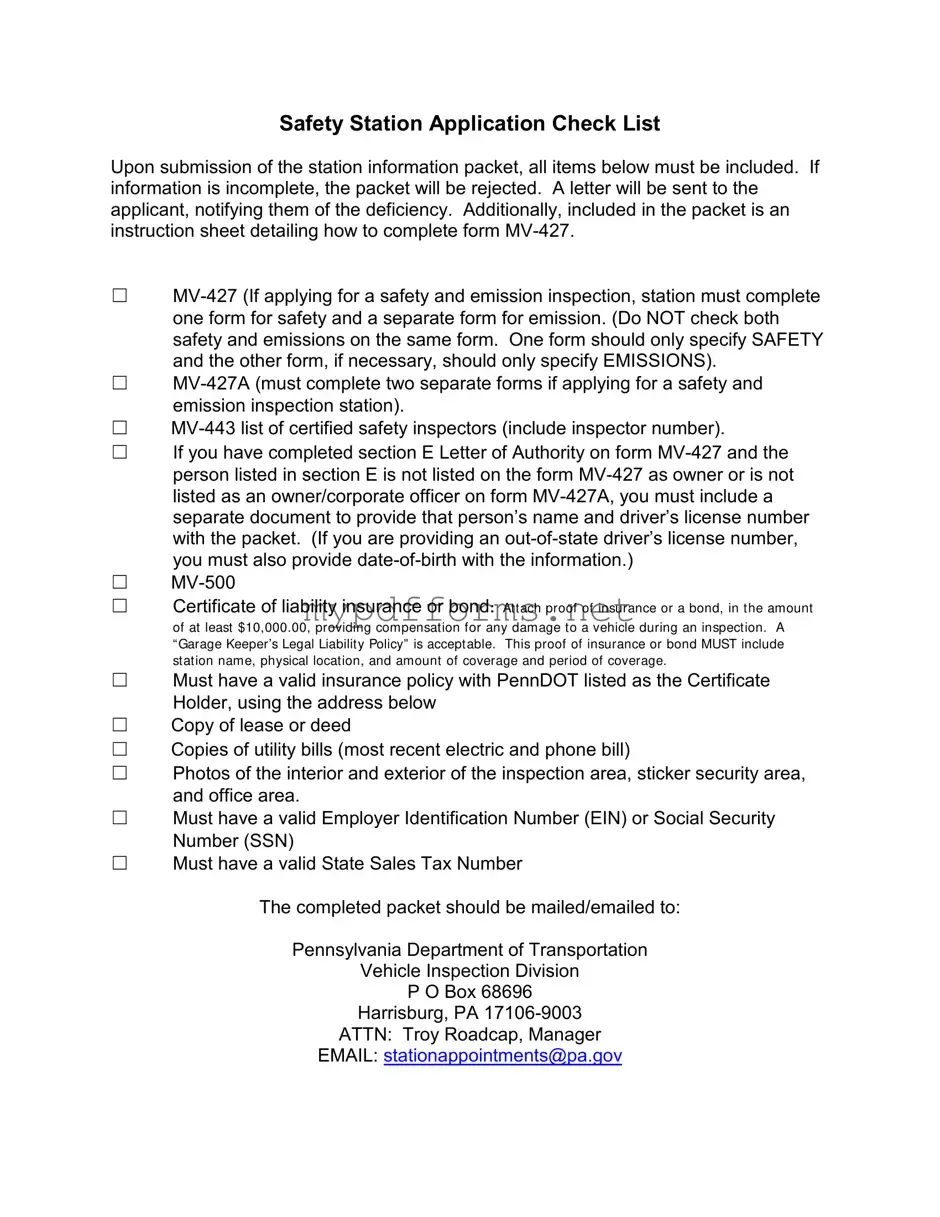The MV-427 form from PennDOT serves as an application for inspection stations, and it shares similarities with various other documents related to vehicle inspections and licensing. One such document is the MV-427A. This form acts as a supplemental application for inspection stations applying for both safety and emissions inspections. Like the MV-427, it requires detailed information about the station and its ownership structure. However, the MV-427A specifically focuses on additional ownership details and insurance acknowledgments, emphasizing the need for separate forms to ensure clarity in applications for different inspection types.
Another relevant document is the MV-443, which is a list of certified safety inspectors. This document is essential for verifying that the personnel conducting inspections are properly certified. Similar to the MV-427, it requires accurate information about inspectors, including their identification numbers. Both forms are crucial for maintaining compliance with safety regulations, ensuring that only qualified individuals are responsible for conducting inspections at the station.
The MV-500 form also bears resemblance to the MV-427, as it pertains to the registration of businesses involved in vehicle-related services. This document requires information about the business entity, including ownership and operational details. Like the MV-427, it aims to ensure that businesses meet the necessary regulatory standards to operate legally within Pennsylvania. Both forms serve as a means of establishing accountability and transparency in the vehicle inspection process.
A Certificate of Liability Insurance is another document akin to the MV-427. This certificate provides proof of insurance coverage for damages incurred during vehicle inspections. Like the MV-427, it mandates specific details, such as the amount of coverage and the name of the inspection station. This requirement underscores the importance of financial protection for both the inspection station and the vehicle owners, ensuring that any potential damages are adequately addressed.
Additionally, the requirement for a copy of the lease or deed is similar to the MV-427 in that it establishes the legitimacy of the business location. This document verifies that the inspection station operates from a legally recognized premises. Both forms are designed to confirm that businesses are compliant with local zoning laws and have the proper authorization to conduct their operations in a specific location.
When navigating the intricacies of various legal forms, it's crucial to understand the implications of each document involved in transactions or inspections. One such resource for acquiring necessary forms is newyorkpdfdocs.com/, which offers a range of essential documentation including the New York Bill of Sale that ensures proper ownership transfer and transaction records.
Utility bills, such as the most recent electric and phone bills, also share a connection with the MV-427. These documents serve as proof of the operational status of the inspection station. Just as the MV-427 requires verification of the business's physical location, utility bills help confirm that the station is actively conducting business and maintaining its facilities. This requirement further emphasizes the importance of transparency and accountability in the inspection process.
Photos of the inspection area, as stipulated in the MV-427, are similarly important to the overall application process. These images provide visual evidence of the station's compliance with safety standards and operational readiness. Like the MV-427, the inclusion of photographs ensures that the inspection area meets the necessary criteria for conducting inspections, thus enhancing the credibility of the application.
Lastly, the need for a valid Employer Identification Number (EIN) or Social Security Number (SSN) is another aspect that aligns with the MV-427. Both documents require identification numbers to establish the legal identity of the business. This requirement is crucial for tax purposes and ensures that all inspection stations are recognized entities within the state’s regulatory framework. Similar to the MV-427, the provision of this information helps maintain a structured and accountable environment for vehicle inspections.
